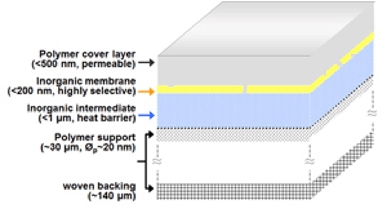The technology is said to have commercial potential for use in coal-fired power plants with carbon capture, utilisation and storage (CCUS) systems.
Before the carbon dioxide (CO2) generated at a power plant can be securely stored or put to beneficial use, it must first be separated from the flue-gas stream. Energy costs associated with this process are, however, too high to make rapid commercial deployment of CCUS technologies feasible.
To overcome this barrier, high-performance membrane separation is a focus of the US Department of Energy’s Fossil Energy (FE) Carbon Capture Program, under which the Ohio State project is managed.
Membranes consist of thin layers of either polymer (organic, plastic) or inorganic (metal, ceramic) materials that are permeable to the molecules they are meant to capture, such as water, CO2 or oxygen.
The layers are generally deposited on a membrane support structure; polymer membranes are mass produced and are very cost effective, while inorganic membranes are expensive to produce but exhibit better performance.
Seawater separation
Scientists occasionally use seawater to illustrate how membranes are more energy efficient than other separation methods.
Pure water can be obtained by boiling the seawater and condensing the salt-free vapour, but boiling requires heat.
Alternatively, membrane processes for separating salt from water don’t require heat, making them more cost effective and environmentally friendly.
Separating CO2 from flue gas is similar: energy is still required for pre- and post-separation processes, such as compressing the gas, but for the key process of separating the CO2, new membrane technologies pioneered by FE’s National Energy Technology Laboratory (NETL) and its research partners are designed to eliminate most of the energy costs.
Ohio State’s new hybrid membrane consists of a thin, inorganic zeolite Y layer sandwiched between an inorganic intermediate and a polymer cover.
These three layers sit atop a polymer support, which in turn rests on a woven backing.
‘Combining inorganic and organic membrane materials in a hybrid configuration is a breakthrough that could potentially lower costs associated with clean coal technologies,’ said NETL project manager José Figueroa in a statement.
Ohio State researchers realised a first prototype by combining new nanotechnology characterisation and fabrication methods with manufacturing techniques. In the laboratory, they were able to cut the zeolite Y growth rate from eight hours to less than 15 minutes and reduce ceramic processing time from 43 hours to 20 minutes, resulting in inorganic/organic membrane development within one hour. They have also achieved adhesion of the inorganic intermediate layer onto a polymer support.
The Ohio State team, which has emphasised the membrane’s broader separation applications in its reports, received funding for the project beginning on 1 October 2011 and presented its first results at the NETL Carbon Capture and Storage meeting on 9–12 July 2012.






Red Bull makes hydrogen fuel cell play with AVL
Formula 1 is an anachronistic anomaly where its only cutting edge is in engine development. The rules prohibit any real innovation and there would be...